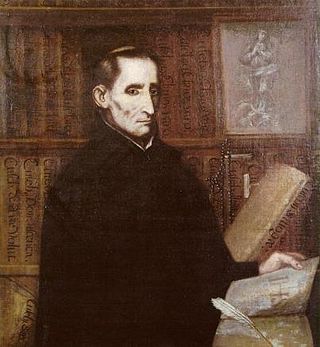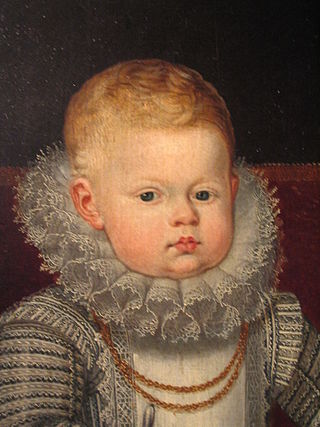Bernardo de Vargas Machuca | |
|---|---|
 | |
| Born | |
| Died | |
| Occupation(s) | Soldier, Writer, Veterinarian, Ecuestrian |
Bernardo de Vargas Machuca (Simancas, 1555 - Madrid, 1622) was a Spanish soldier, writer, naturalist, veterinarian and conquistador.
Bernardo de Vargas Machuca | |
|---|---|
 | |
| Born | |
| Died | |
| Occupation(s) | Soldier, Writer, Veterinarian, Ecuestrian |
Bernardo de Vargas Machuca (Simancas, 1555 - Madrid, 1622) was a Spanish soldier, writer, naturalist, veterinarian and conquistador.
Bernardo de Vargas Machuca was born in Simancas, a town in the present-day Province of Valladolid, in 1555 (some sources say 1557), to Juan Vargas, warden of the castle in that town, and Angela de Soto. [1] He completed his studies in the city of Valladolid, enlisting at a very early age in the Spanish Army. He served in Italy and in the colonization of the Americas. During his stay in the American continent he lived in Bogotá, capital city of the New Kingdom of Granada. [2]

After retiring from his military career he settled in the new capital of the Hispanic Monarchy, Madrid. During this period he wrote and published several works in which he collected his impressions and research, including Milicia y descripción de las Indias (The Indian Militia and Description of the Indies) in 1599, also known as Milicia Indiana, a manual intended for Spanish officers serving in the New World. [3] [4] He also published in 1621 Compendio y Doctrina Nueva de la Gineta (Compendium and New Doctrine of Gineta Horsemanship), one of the main studies on Jineta horsemanship of the time, dedicated to Count Alberto Fúcar (Albert Fugger), member of the German House of Fugger, [5] and another essay written around 1603 titled Defensa de la conquista de las Indias (Defense of the Conquest of the Indies), in which he refutes and rejects the ideas and arguments in Bartolomé de las Casas’s A Short Account of the Destruction of the Indies (1552), although it was never published. [6] He died in the Spanish capital in 1622.

The vaquero is a horse-mounted livestock herder of a tradition that has its roots in the Iberian Peninsula and extensively developed in Mexico from a method brought to the Americas from Spain. The vaquero became the foundation for the North American cowboy, in Northern Mexico, Southwestern United States, and Western Canada.

Gabriel Téllez, O. de M., also known as Tirso de Molina, was a Spanish Baroque dramatist and poet, as well as a Mercedarian friar, and Catholic priest. He is primarily known for writing The Trickster of Seville and the Stone Guest, the play from which the character Don Juan originates. His work also includes female protagonists and the exploration of sexual issues.

Antonio de León Pinelo (1589–1660) was a historian from the Viceroyalty of Peru.

Antonio de Herrera y Tordesillas was a chronicler, historian, and writer of the Spanish Golden Age, author of Historia general de los hechos de los castellanos en las Islas y Tierra Firme del mar Océano que llaman Indias Occidentales, better known in Spanish as Décadas and considered one of the best works written on the conquest of the Americas. Herrera never visited or lived in any part of the Americas. Therefore his work was largely conjectural.

Juan Eusebio Nieremberg y Ottín was a Spanish Jesuit, polymath and mystic.
Fray Antonio Vazquez de Espinosa was a Spanish friar of the Discalced Carmelites originally from Jerez de la Frontera whose Compendio y Descripcion de las Indias Occidentales has become a source of detail for the history of South America, since the manuscript's discovery in the Vatican Library in 1929.

The Spanish East Indies were the colonies of the Spanish Empire in Asia and Oceania from 1565 to 1901, governed through the captaincy general in Manila for the Spanish Crown, initially reporting to Mexico City, then later directly reporting to Madrid after the Spanish American Wars of Independence.

The Roman CatholicDiocese of San Cristóbal de Las Casas is a suffragan diocese of the Archdiocese of Tuxtla. Its see is in San Cristóbal de las Casas in Chiapas. In November 2017 Rodrigo Aguilar Martínez was appointed new bishop on the resignation of Bishop Felipe Arizmendi Esquivel.

Santa Rosa is a Colombian municipality located in the department of Cauca, in the region known as the Bota Caucana. It is located on the eastern slope of the Colombian Massif, the mountainous area where the Central and Oriental Cordilleras merge. Its economy is based on agriculture, its main products are corn, sugar cane, plantain and livestock. It includes the corregiments of Carmelo, San Juan de Villalobos and Descanse.
El Carnero is the colloquial name of a Spanish language colonial chronicle whose title was Conquista y descubrimiento del Nuevo Reino de Granada de las Indias Occidentales del mar océano, y fundacion de la ciudad de Santafé de Bogotá, ... [also known as El Carnero de Bogotá]. It is a chronicle of history and customs written in 1636-1638 by Bogota-born Juan Rodríguez Freyle.

Juan Bautista Muñoz was an 18th-century Spanish philosopher and historian. He wrote a major history of Spain and Spanish America, using Spanish archival resources, and was the driving force behind the creation of the Archive of the Indies. That brought into a single repository all the documents pertaining to the administration of Spanish overseas possessions.
Miguel Holguín y Figueroa, also written as Miguel Holguín de Figueroa, was a Spanish conquistador. He took part in the expeditions of conquest of the Chitarero, Motilon, U'wa and Lache peoples led by Nikolaus Federmann. Holguín y Figueroa later settled in Tunja, where he protested the rapacious activities of Hernán Pérez de Quesada, governor of Bogotá.

Ortún Velázquez de Velasco was a Spanish conquistador. He is known as the co-founder and first governor of Pamplona in the Norte de Santander department of Colombia, which borders Venezuela.
Juan Tafur was a Spanish conquistador who participated in the Spanish conquest of the Muisca people. He was a cousin of fellow conquistadors Martín Yañéz Tafur, Hernán Venegas Carrillo and Pedro Fernández de Valenzuela. Juan Tafur was five times encomendero (mayor) of Santa Fe de Bogotá. He also received the encomiendas of Pasca, Chipaque and Usaquén. The encomienda of Suesca was shared between Tafur and Gonzalo García Zorro.
Martín Yañéz Tafur was a Spanish conquistador who participated in the foundation of Cartagena, the Spanish conquest of the Muisca and the conquest of the Panche.
Gonzalo García Zorro was a Spanish conquistador who participated in the Spanish conquest of the Muisca people. García Zorro was encomendero (mayor) of Santa Fe de Bogotá for seven terms, and received the encomiendas of Fusagasugá and Fosca.
Antonio Díaz de Cardoso was a Portuguese conquistador who participated in the Spanish conquest of the Muisca people.

Alonso of Spain was an infante of Spain, who died in childhood.

Juan Suárez de Peralta was a Spanish-Mexican Criollo who distinguished himself for his writings on equestrian exercises and equine science, as well as life in New Spain in the 16th century. He is considered a historian for dealing with the subject of the Conquest, and one of the first scholars of albeytería, later known as veterinary medicine in the New World, for his extensive knowledge of horses.

Doña Asunción de Zea-Bermúdez y Montoya was a Spanish writer and essayist.